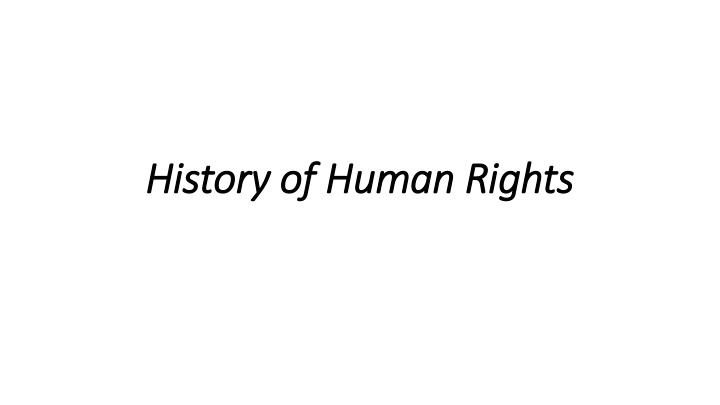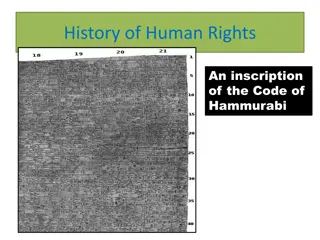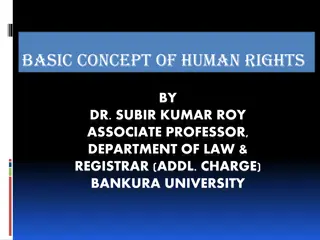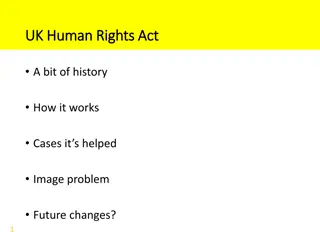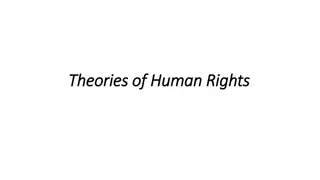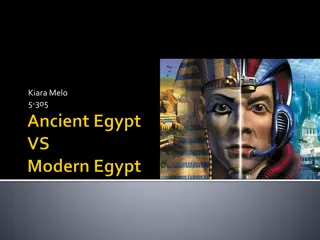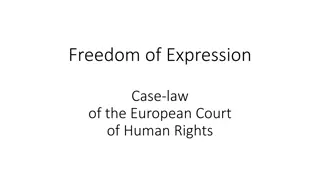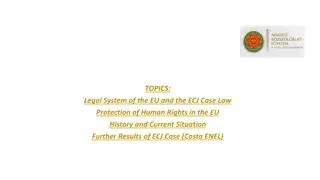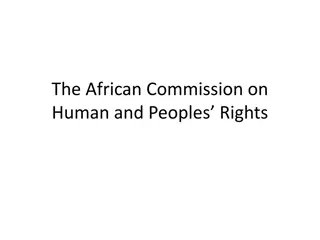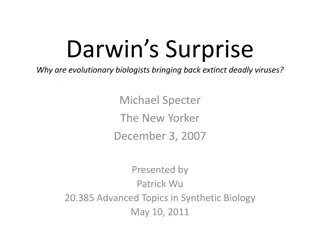Evolution of Human Rights: From Ancient Times to Modern Era
Throughout history, ideas of rights and liberty have evolved, leading to the recognition of universal human rights in the modern sense. The concept of human rights can be traced back to significant historical events such as the English Bill of Rights, the Virginia Declaration of 1776, and the French Declaration of the Rights of Man and of the Citizen. In the 19th and 20th centuries, various movements and reformers, including labor unions, women's rights groups, and civil rights movements, have further shaped and advanced the cause of human rights. The post-World War II period marked the widespread acceptance of international human rights standards, solidifying the importance of human rights on a global scale.
Download Presentation

Please find below an Image/Link to download the presentation.
The content on the website is provided AS IS for your information and personal use only. It may not be sold, licensed, or shared on other websites without obtaining consent from the author.If you encounter any issues during the download, it is possible that the publisher has removed the file from their server.
You are allowed to download the files provided on this website for personal or commercial use, subject to the condition that they are used lawfully. All files are the property of their respective owners.
The content on the website is provided AS IS for your information and personal use only. It may not be sold, licensed, or shared on other websites without obtaining consent from the author.
E N D
Presentation Transcript
History of Human Rights History of Human Rights
Ideas of rights and liberty have existed for much of human history but it is unclear to what degree such concepts can be described as human rights in the modern sense. Because although the concept of rights existed in the pre- modern cultures; but these rights cannot be described as the universal human rights; slavery, for instance, was justified in both ancient and modern times as a natural condition. Moreover, medieval charters of liberty such as the English Magna Charta were not charters of human rights; they instead constituted a form of limited political and legal agreement to address specific political circumstances.
Therefore, the basis of most modern legal interpretations of human rights can be traced back to the recent European history. The Twelve Articles (1525)are considered to be the first record of human rights in this regard which were the part of the peasants, demands raised towards the Swabian League in the German Peasants War in Germany. While in 1542 in Spain the famous Valladolid Debate was conducted in which Bartolome de Las Cases strongly argued for equal rights to freedom of slavery. Then in 1683 in Britain, the English Bill of Rights and the Scottish Claim of Rights were passed each of which made illegal range of oppressive governmental actions. After that the Virginia Declaration of 1776 was adopted which encoded into law a number of fundamental civil rights and freedoms of individuals. Not only this it also influenced a no. of later documents, including the United States Declaration of Independence (1776) and the French Declaration of the Rights of Man and of the Citizen (1789), respectively both of which established certain legal rights of the individuals.
Then in the 19th century, human rights became a central concern over the issue of slavery and a number of reformers worked towards its abolition. Moreover, many groups and movements achieved profound social changes over the course of the 20th century in the name of human rights. In this regard labour unions, women s rights movements, National liberation movements (which succeeded in many countries in driving out the colonial powers), African American Civil Rights Movement, and more recent diverse identity politics movements, on behalf of women and minorities in the United States are of great importance.
But all this was just the beginning. The actual content and widespread acceptance of the international human rights standards emerged largely in the post-World War II period, following the atrocities that transformed human rights from a domestic matter into an international concern. The victorious Allies, meeting in Dumbarton Oaks to discuss and negotiate the formation of the international body that would become the United Nations (UN) (1945), stated that ensuring respect for the human rights and fundamental freedoms would be one of its purposes.
This was the first time that the words human rights were used in an international treaty. Following the World War II, the United Nations and its members developed much of the discourse and the bodies of law that now make up international humanitarian law and international human rights law. The year 1948 will be remembered as a great achievement in this regard. Because, in this year, the United Nations General Assembly adopted the Universal Declaration of Human Rights (UDHR) which is considered as a Magna Charta in the history of human rights as it provides a uniform standard of human rights to all nations and regions, irrespective of their backgrounds, cultures, religions and ideologies.
However, beyond the UDHR, a number of other treaties and conventions have also been adopted by the UN General Assembly that create rights for individuals and also create obligations for the states that ratify them.
